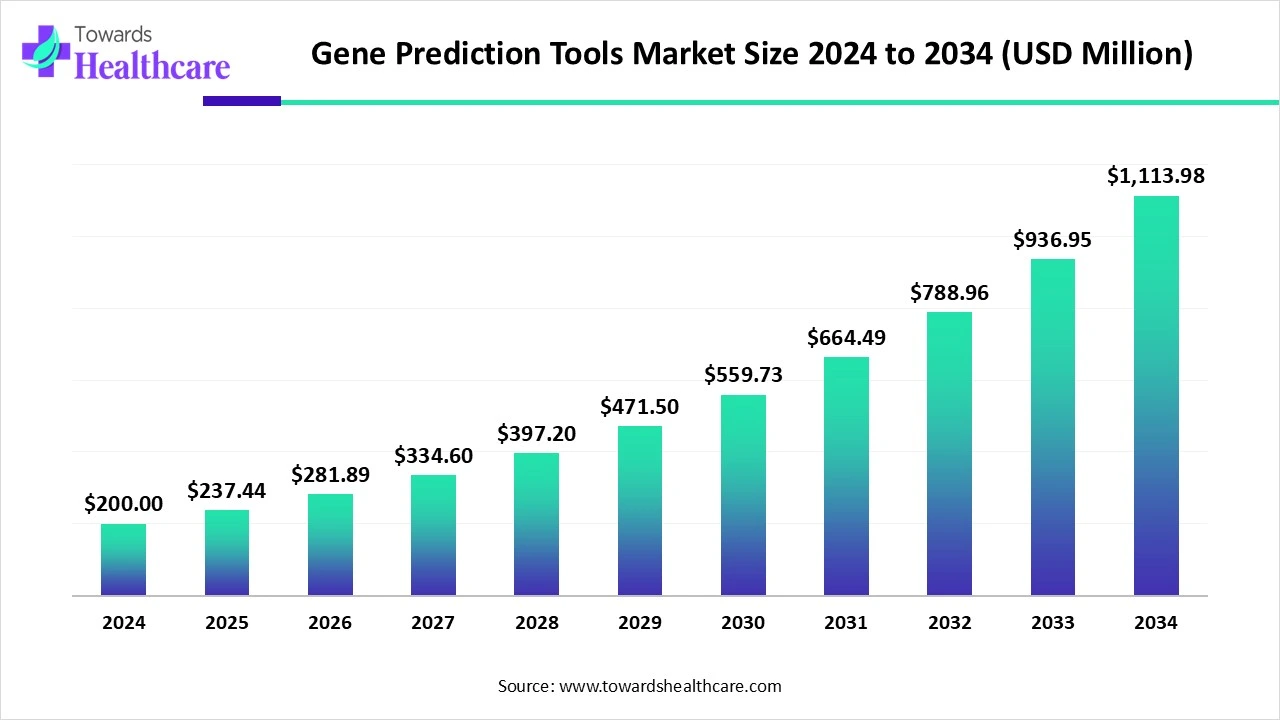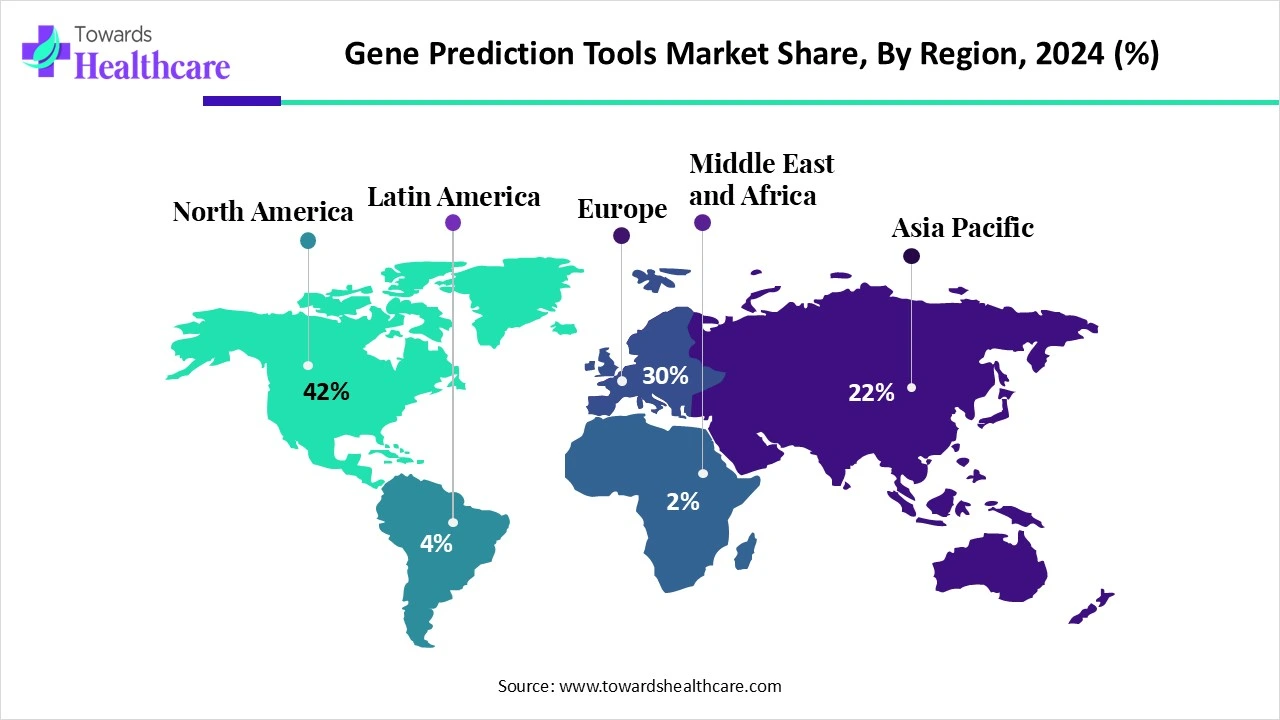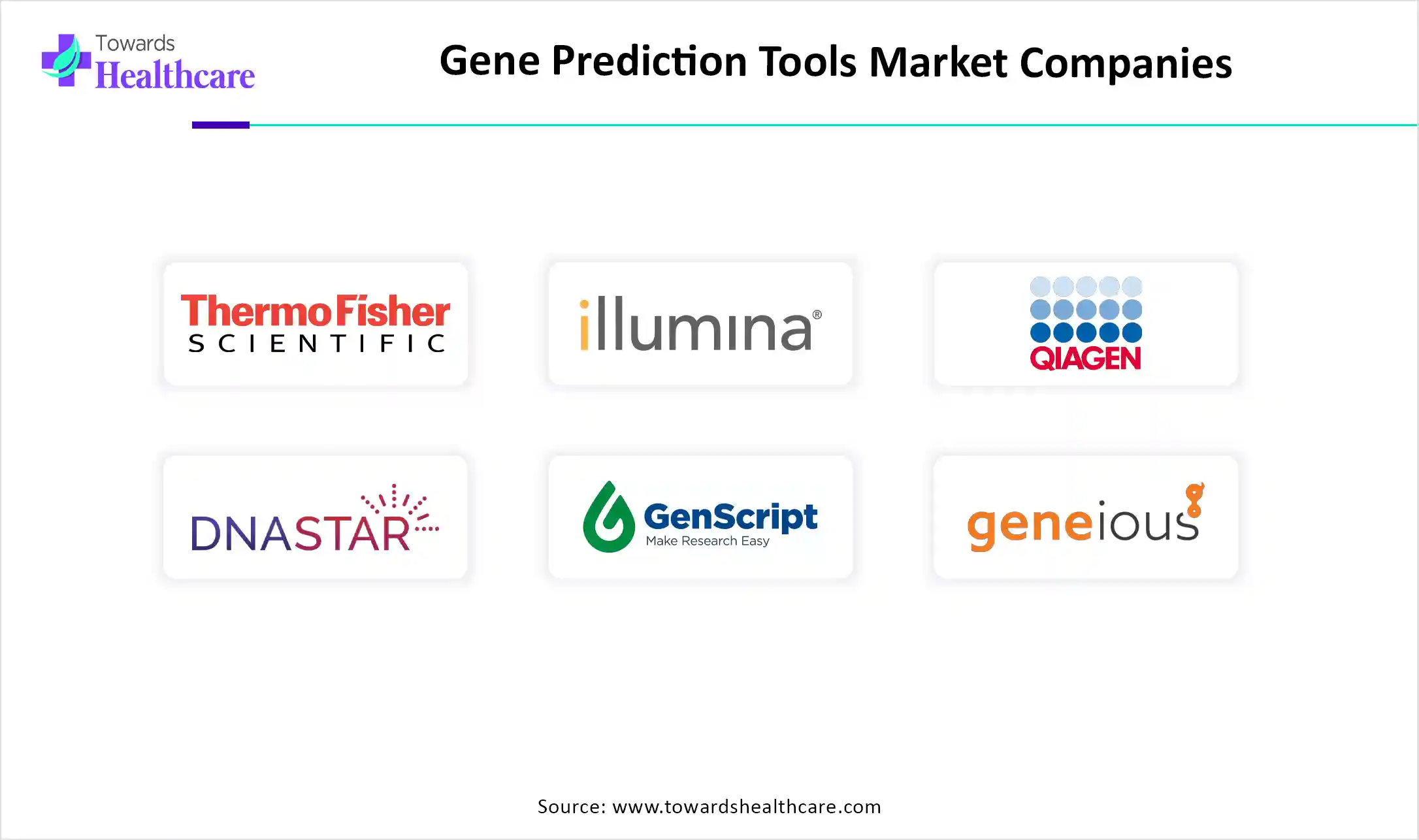November 2025

The global gene prediction tools market size is calculated at US$ 200 in 2024, grew to US$ 237.44 million in 2025, and is projected to reach around US$ 1113.98 million by 2034. The market is expanding at a CAGR of 18.72% between 2025 and 2034.
The global gene prediction tools market is experiencing major growth due to different contributing factors, including rising chronic and rare conditions, which require the development of personalized treatments, along with the growing large-scale genomic projects in various regions across the world. Furthermore, accelerating government initiatives and funding in genomic research and advancements in the integration of AI and ML algorithms used in gene prediction tools are fueling the market expansion.
These reasons are assisting in generating new opportunities in the coming years, advancing next-generation sequencing technologies are generating huge datasets, as well as boosting developments in diagnostic tools used in the diagnosis of different disorders.

| Metric | Details |
| Market Size in 2025 | USD 237.44 Million |
| Projected Market Size in 2034 | USD 1113.98 Million |
| CAGR (2025 - 2034) | 18.72% |
| Leading Region | North America share by 42% |
| Market Segmentation | By Type, By Method, By Application, By End-Use, By Region |
| Top Key Players | Thermo Fisher Scientific, Illumina, Qiagen, Softberry, DNASTAR, BGI Genomics, Genscript, Geneious, AZoLifeSciences, MedGenome, Sino Biological, Syngene, Twist Bioscience |
The bioinformatics software programs that are created to determine and locate genes within a DNA sequence are known as gene prediction tools. Whereas these are highly employed in the analysis of DNA sequences to estimate the presence of protein-coding regions (genes) and their limitations, such as exons, introns, and splice sites. The global gene prediction tools market is driven by breakthroughs in genomic technologies, the increasing demand for personalized medicine, and genomic data analysis. They have broad applications in various areas like drug discovery, diagnostics, and agriculture.
AI algorithms have a major role in the respective market, as they help in increasing accuracy, speed, and the ability to manage huge datasets. It is widely propelled by continuous novel creations in genomic and bioinformatics areas, rising adoption of integrated AI in the healthcare sector. Moreover, AI algorithms are highly employed in personalized medicine development, as well as in drug discovery, disease risk anticipation, and precision medicine applications.
For instance,
Growing Demand for Personalized Medicine and Reducing Expenses
Globally, increasing demand for personalized medicine depends on an individual's genetic makeup, creating precise gene prediction necessary for customizing treatments and therapies. Also, the rising integration of computational biology in different sectors, like agriculture and synthetic biology, and the sequencing enabling more affordable, more research and clinical applications, are driving the advanced gene prediction tools market growth.
High Computational Expenses and Data Complexity
In gene prediction tools, AI and machine learning need significant computing power, measurable cloud infrastructure, and robust storage solutions are escalating overall operational expenditure is generating a challenge in front of the market expansion. Besides this, huge genomic datasets possessing the complexity of eukaryotic genomes are also posing a barrier in the respective market.
Accelerating NGS Data and Diagnostics Development
In the future, the gene prediction tools market is expected to present several opportunities, including the proliferation of NGS technologies, the generation of a large volume of genomic data, and the development of robust demand for potential gene prediction tools. In addition to these tools being employed in the identification of genetic variations linked to diseases, their coupling in the development of diagnostic tests is fueling their adoption.
By type, the software segment held the largest revenue share of the market in 2024. The most important contributing factors in the dominance of this segment are advancements in genomics like NGS technologies, accelerating research investments, and growing demand for precision medicine. Besides this, progressing NGS technologies need sophisticated analysis tools to generate a huge volume of datasets, along with integrated AI and ML into gene prediction software, which furthermore assists in market transformation.
By type, the services segment is expected to grow rapidly over the projected period. The majorly segment is fueled by the rising outsourcing of gene prediction services to specialized providers by numerous pharmaceutical and biotechnology companies, especially for drug discovery and development, along with the escalating vast datasets from large-scale sequencing projects, including the Human Genome Project, which need tools and services for the analysis and interpretation of this information.
By method, the empirical methods segment dominated the gene prediction tools market and is expected to grow at the fastest CAGR during the forecast period. Primarily, accelerating demand for integration with high-throughput technologies, widespread applications across research and clinical areas, and robust collaboration between academic and industry leaders are propelling the segment expansion. Moreover, boosting prospective investment in genomic research, the adoption of AI in bioinformatics is also supporting the overall market and segment growth.
By application, the drug discovery & development segment led the market by capturing a major revenue share of the market in 2024. Various pharmaceutical and biotechnology companies are heavily investing in R&D, which demands gene prediction tools in drug discovery. As well as the increasing biologics, such as antibodies, gene therapies, and precision therapies, which require gene expression analysis to recognize gene activity and improve the drug development process, are impacting the segment growth.
By application, the diagnostics development segment is expected to grow fastest during 2025-2034. In the coming era, the segment is fueled by the growing awareness and rising diagnosis of genetic concerns, which need genetic testing and diagnostics is influencing the development of this segment. Along with this, nowadays, there is consistent optimization in DNA sequencing, and other genomic technologies are allowing more precise and effective gene prediction, propelling demand for highly advanced diagnostic tools.
By end-use, the industrial segment dominated by contributing a major revenue share of the global gene prediction tools market in 2024. Currently, the increasing collaborations between industries and research institutions, as well as the rising adoption of gene prediction tools to improve metabolic pathways, design synthetic genomes, and simplify bioproduction operations in industries, are fueling the segment's development.
By end-use, the academic & research segment is expected to be the fastest-growing segment over the projected period. The segment is driven by the enhanced funding and government initiatives in genomic research, like gene prediction, to improve scientific understanding and boost public health. Furthermore, these institutions possess ethical and regulatory guidelines regarding these research activities, resulting in the progress of gene prediction tools that take ethical considerations into account, supporting the ultimate gene prediction tools market expansion as well.

North America was dominant in the market share by 42% in 2024. In North America, the market is impelled by the growing number of chronic disease cases, including cancer, cardiovascular conditions, and diabetes, demanding gene prediction tools to enhance personalized treatments. Also, they have a robust academic ecosystem, strong funding facilities, and the presence of major genome annotation projects are widely contributing to the market’s growth.
In the US, the accelerating large-scale Human genome projects, along with an exceptional rise in genomic data by using advanced technologies such as Next-Generation Sequencing (NGS), are driving the need for more sophisticated tools in the analysis and interpretation of this data is impacting market expansion.
The market is propelled by several factors, including growing government funding in genomic research, along with the rising adoption of cloud-based gene prediction tools are generating feasible and scalable as well and affordable solutions.
Asia Pacific is expected to be the fastest-growing region during the forecast period. In ASAP, the most significant contribution by the government in countries like China and India is to encourage genomics research and healthcare innovation, generating a robust environment for the respective markets. Besides this, thriving biotechnology industries in the ASAP region, having a focus on gene editing and synthetic biology areas of the biotechnology field, are majorly contributing to the demand for these prediction tools in many studies.
China is experiencing major growth, as they have adopted advancements in sequencing technologies like NGS in large-scale projects, including agriculture and biotechnology sectors, as well as the rising usage of integrated AI with ML in the development of gene prediction tools.
India is also leading the market due to growing cases of chronic diseases and rising awareness about the adoption of personalized treatments in those conditions. Also, many initiatives by the government, such as the National Health Policy and BIRAC in India, are supporting research activities involving genomics, which is further stimulating the expansion of the market.
Europe is experiencing significant growth in the market, driven by the escalating genomic research activities, especially in areas including cancer and rare diseases, which are pushing demand for gene prediction tools. Although bioinformatics is playing a pivotal role in developing these tools, it allows for more accurate identification of genes, annotations, and functional analysis.
As bioinformatics has a major role in the European market, along with AI and machine learning are revolutionizing gene prediction by optimizing accuracy, pace, and scalability, are driving the market.
In the UK, the growing awareness about early disease diagnosis and boosting the drug development process, which demands for widespread adoption of gene prediction tools, and ultimately impacts the market growth.

By Type
By Method
By Application
By End-Use
By Region
According to market projections, the global complement C4 antibody market, valued at USD 21.56 billion in 2024...
Market insights predict, the gRNA industry is expected to grow from USD 592.66 million in 2024 to USD 3,296.45...
According to market projections, the genome editing sector is expected to grow from USD 9.39 billion in 2024 t...
Market insights predict, the carrier screening industry is expected to grow from USD 3.09 billion in 2025 to U...
November 2025
November 2025
November 2025
November 2025